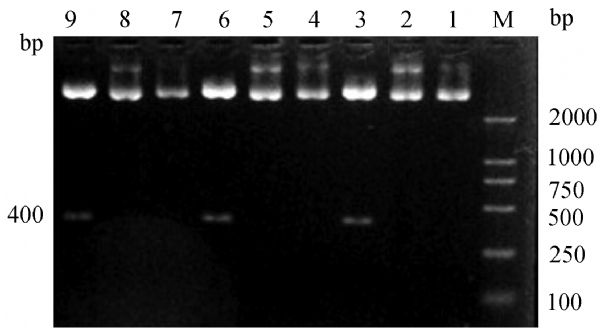

Gene silencing efficiency of shRNA expression vectors targeting Cx43 in vitro
Received date: 12 Nov 2008
Accepted date: 05 Jan 2009
Published date: 05 Jun 2009
Copyright
Our previous studies showed that there were close relationships between connexin 43 (Cx43) and acupoints and meridians. In order to further investigate the effect of Cx43 in acupuncture treatment, RNA interference technique was used to construct small hairpin RNA (shRNA) expression vectors targeting Cx43 and identify the efficiency of RNA interference in NIH/3T3 cell lines for further use in vivo. Aiming directly at the two targets of Cx43 mRNA sequence of the rat and mouse homology region, we synthesized two pairs of complementary oligonucleotide strands in vitro. Double strands were formed after annealing, and then inserted into Pgenesil-1 plasmid expression vector. After identification by enzyme cutting and sequencing, the recombinant plasmids named P-Cx43-shRNA (1), P-Cx43-shRNA (2) and P-con-shRNA were transfected into the NIH/3T3 cells. Immunofluorescence and Western blot assays were used to detect the protein level of Cx43 after being screened by G418.The results of enzyme cutting and sequencing showed that we successfully constructed two shRNA expression vectors targeting Cx43, and a control expression vector for rat and mouse. Also, the Cx43 protein level was decreased by 73.5% (P< 0.01) and 10.8%, accordingly. The Cx43 protein level was not influenced by the transfection of P-con-shRNA. The outcomes demonstrate that the plasmid P-Cx43-shRNA (1) can specifically silence better the expression of Cx43 in NIH/3T3 cells, which offers an experimental evidence for further in vivo investigation.

Key words: RNA interference; connexin 43; small hairpin RNA (shRNA); acupuncture
Cuihong ZHENG , Yunxia WU , Guangying HUANG , Wei WANG . Gene silencing efficiency of shRNA expression vectors targeting Cx43 in vitro[J]. Frontiers of Medicine, 2009 , 3(2) : 130 -135 . DOI: 10.1007/s11684-009-0030-9
| 1 |
LairdD W. Life cycle of connexins in health and disease. Biochem J, 2006, 394 (Pt 3): 527-543
|
| 2 |
AnandR J, HackmD J. The role of gap junctions in health and disease. Crit Care Med, 2005, 33(12 Suppl): S535-538
|
| 3 |
EvansW H, MartinP E. Gap junctions: structure and function. Mol Membr Biol, 2002, 19(2): 121-136
|
| 4 |
AritaK, AkiyamaM, TsujiY, McMillanJ R, EadyR A, ShimizuH. Changes in gap junction distribution and connexin expression pattern during human fetal skin development. J Histochem Cytochem, 2002, 50(11): 1493-1500
|
| 5 |
SalomonD, MasgrauE, VischerS, UllrichS, DupontE, SappinoP, MedaP. Topography of mammalian connexins in human skin. J Invest Dermatol, 1994, 103(2): 240-247
|
| 6 |
ZhengC H, HuangG Y, ZhangM M, XiaoY L. Experimental study on expression of connexin 43 in meridians of rats. Zhongguo Zhen Jiu, 2005, 25(9): 629-632 (in Chinese)
|
| 7 |
HuangG Y, ZhengC H, ZhangM M. Effect of acupuncture on expression of connexion 43 in “Zusanli” (ST 36) of the rat. Zhongguo Zhen Jiu, 2005, 25(8): 565-568 (in Chinese)
|
| 8 |
ElbashirS M, HarborthJ, LendeckelW, YalcinA, WeberK, TuschlT. Duplexes of 21-nucleotide RNAs mediate RNA interference in cultured mammalian cells. Nature, 2001, 411(6836): 494-498
|
| 9 |
ElbashirS M, LendeckelW, TuschlT. RNA interference is mediated by 21- and 22-nucleotide RNAs. Genes Dev, 2001, 15(2): 188-200
|
| 10 |
McManusM T, SharpP A. Gene silencing in mammals by small interfering RNAs. Nat Rev Genet, 2002, 3(10): 737-747
|
| 11 |
DykxhoornD M, NovinaC D, SharpP A. Killing the messenger: short RNAs that silence gene expression. Nat Rev Mol Cell Biol, 2003, 4(6): 457-467
|
| 12 |
CaplenN J, ParrishS, ImaniF, FireA, MorganR A. Specific inhibition of gene expression by small double-stranded RNAs in invertebrate and vertebrate systems. Proc Natl Acad Sci USA, 2001, 98(17): 9742-9747
|
| 13 |
MicuraR. Small interfering RNAs and their chemical synthesis. Angew Chem Int Ed Engl, 2002, 41(13): 2265-2269
|
| 14 |
DonzeO, PicardD. RNA interference in mammalian cells using siRNAs synthesized with T7 RNA polymerase. Nucleic Acids Res, 2002, 30(10): e46
|
| 15 |
MyersJ W, JonesJ T, MeyerT, FerrellJ E Jr. Recombinant Dicer efficiently converts large dsRNAs into siRNAs suitable for gene silencing. Nat Biotechnol, 2003, 21(3): 324-328
|
| 16 |
MiyagishiM, TairaK. U6 promoter-driven siRNAs with four uridine 3' overhangs efficiently suppress targeted gene expression in mammalian cells. Nat Biotechnol, 2002, 20(5): 497-500
|
| 17 |
ScherrM, MorganM A, EderM. Gene silencing mediated by small interfering RNAs in mammalian cells. Curr Med Chem, 2003, 10(3): 245-256
|
| 18 |
McCaffreyA P, MeuseL, PhamT T, ConklinD S, HannonG J, KayM A. RNA interference in adult mice. Nature, 2002, 418 (6893): 38-39
|
| 19 |
LewisD L, HagstromJ E, LoomisA G, WolffJ A, HerweijerH. Efficient delivery of siRNA for inhibition of gene expression in postnatal mice. Nat Genet, 2002, 32(1): 107-108
|
| 20 |
SongE, LeeS K, WangJ, InceN, OuyangN, MinJ, ChenJ, ShankarP, LiebermanJ. RNAβinterferenceβtargetingβFasβprotectsβmiceβfromβfulminant hepatitis.ββNatβMed,β2003, 9(3): 347-351
|
| 21 |
ZenderL, HutkerS, LiedtkeC, TillmannH L, ZenderS, MundtB, WaltematheM, GoslingT, FlemmingP, MalekN P, TrautweinC, MannsM P, KuhnelF, KubickaS.βCaspaseβ8βsmallβinterferingβRNAβpreventsβacuteβliverβfailureβinβmice.ββProc Natl Acad Sci U S A,β2003, 100(13): 7797-7802
|
/
| 〈 |
|
〉 |